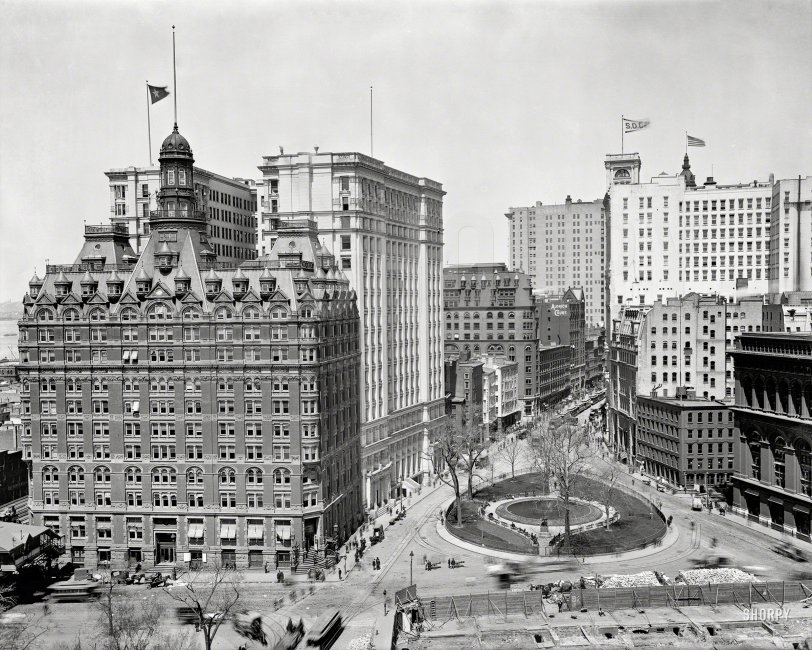


Framed or unframed, desk size to sofa size, printed by us in Arizona and Alabama since 2007. Explore now.
Shorpy is funded by you. Patreon contributors get an ad-free experience.
Learn more.

- Baldwin 62303
- Baldwin VO-1000
- Cold
- No expense spared
- Tough Guys
- Lost in Toyland
- And without gloves
- If I were a blindfolded time traveler
- Smoke Consumer Also Cooks
- Oh that stove!
- Possibly still there?
- What?!?
- $100 Reward
- Freeze Frame
- Texas Flyer wanted
- Just a Year Too Soon
- WWII -- Replacing men with women at the railroad crossing.
- Yes, Icing
- You kids drive me nuts!
- NOT An Easy Job
- I wonder
- Just add window boxes
- Icing Platform?
- Indiana Harbor Belt abides
- Freezing haze
- Corrections (for those who care)
- C&NW at Nelson
- Fallen Flags
- A dangerous job made worse
- Water Stop
Print Emporium
Bowling Green: 1900

New York circa 1900. "Bowling Green and Broadway." Oldest public park in the city. 8x10 inch glass negative, Detroit Publishing Company. View full size.
Washington Building
The "turreted" building on the left at No. 1 Broadway is the Washington Building, designed by Edward H. Kendall and built 1882-1885. Believe it or not, it is still there, but you would hardly recognize it. It was completely refaced in white limestone c. 1922 and renamed the International Merchant Marine Company Building. In the process the building lost its colorful red brick facade, its frenetic roofline, and its tower. Across Bowling Green is another red brick structure of the 1880s, George B. Post's Produce Exchange Building of 1881-1884. This handsome edifice (of which you can see only the last 3 bays or so) was widely admired as one of Post's best designs, and it even had a very early use of skeleton framing in its upper story interior light court. Alas, the Produce Exchange was demolished c. 1955 and replaced by the (to put it charitably) nondescript building called Number 2 Broadway.
Query
What's the turreted building on the left?
A Lot of Bull
About the only thing AleHouseMug omitted is that the famous Wall Street Bull now stands just north of the park. It is where Broadway divides, approximately straight through the tops of the trees in this view.
Under Construction
Looks like the Customs House is about to be built by the construction site in the foreground. Now the home of the National Museum of the American Indian, and Federal Bankruptcy Court. (And most recently added the National Archives.) Beautiful Cass Gilbert building. Almost torn down in 1970's NYC.
The Produce Exchange is on the extreme right - the building that replaced it would be Jack Lemmon's office in the movie The Apartment.
Standard Oil is on the right as well - you can see the pennant on the roof, and the White Star Line is on the left -
The fence around the park was put into storage when the subway was built, and lost for many years. The fence had the Royal emblem on the main posts and were snapped off when independence was declared. There was also a lead statue of King George III that was smashed and turned into musket balls. Old George was on a horse, and the tail of that horse is in the collection of the N-Y Historical Society. If you look at the fence today, you can see where the emblem was ripped from the posts.
There is a story that bowling got its 10th pin in this park when the Dutch outlawed the playing of 9 pins on Sunday.
Rent for the park? One pepper corn per year. I've tried in vain to find out the last time that was paid.
The statue is Abraham De Peyster - he gets moved a lot. He was once where you see him, then at the north end of the park, recently he was a few blocks away in Hanover Sq., and now he is in Foley Sq. The much moved former mayor of NYC.
Before the subway
Is that a steam locomotive at the elevated station at the lower left?
























On Shorpy:
Today’s Top 5